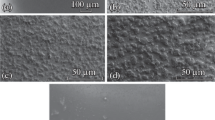Abstract
A grafting-to approach is described as a means of fabricating ultrathin, oil-compatible, friction-reducing coatings. The tribological properties of grafted-to coatings of poly(dodecyl methacrylate) (P12MA), prepared by means of a photoactivated perfluorophenylazide adhesion promoter, were compared with those of grafted-from coatings of the same polymer of comparable molecular weight, prepared via surface-initiated, atom-transfer radical polymerisation. It was shown that in a sub-hydrodynamic regime (i.e. boundary/brush lubrication), both coating types can be equivalently effective, exhibiting very low friction coefficients (0.02) against a bare silica countersurface with no detectable wear over the duration of the test (around 1,000 cycles, and maximal Hertzian contact pressure ca 170 MPa as calculated for a bare–bare configuration), providing that sufficiently viscous base lubricants are employed.








Similar content being viewed by others
References
Klein, J.: Shear of polymer brushes. Colloids Surf. A 86, 63–76 (1994)
Binder, K., Kreer, T., Milchev, A.: Polymer brushes under flow and in other out-of-equilibrium conditions. Soft Matter 7, 7159–7172 (2011)
Zhao, B., Brittain, W.J.: Polymer brushes: surface-immobilized macromolecules. Prog. Polym. Sci. 25(5), 677–710 (2000)
Ma, H.W., Wells, M., Beebe, T.P., Chilkoti, A.: Surface-initiated atom transfer radical polymerization of oligo(ethylene glycol) methyl methacrylate from a mixed self-assembled monolayer on gold. Adv. Funct. Mater. 16(5), 640–648 (2006)
Ulman, A.: Formation and structure of self-assembled monolayers. Chem. Rev. 96, 1533–1554 (1996)
Fan, X.W., Lin, L.J., Dalsin, J.L., Messersmith, P.B.: Biomimetic anchor for surface-initiated polymerization from metal substrates. J. Am. Chem. Soc. 127, 15843–15847 (2005)
Heeb, R., Lee, S., Venkataraman, N.V., Spencer, N.D.: Influence of salt on the aqueous lubrication properties of end-grafted, ethylene glycol-based self-assembled monolayers. ACS Appl. Mater. Interfaces 1(5), 1105–1112 (2009)
Pasche, S., De Paul, S.M., Voros, J., Spencer, N.D., Textor, M.: Poly(l-lysine)-graft-poly(ethylene glycol) assembled monolayers on niobium oxide surfaces: a quantitative study of the influence of polymer interfacial architecture on resistance to protein adsorption by ToF-SIMS and in situ OWLS. Langmuir 19(22), 9216–9225 (2003)
Saxer, S., Portmann, C., Tosatti, S., Gademann, K., Zürcher, S., Textor, M.: Surface assembly of catechol-functionalized poly(l-lysine)-graft-poly(ethylene glycol) copolymer on titanium exploiting combined electrostatically driven self-organization and biomimetic strong adhesion. Macromolecules 43(2), 1050–1060 (2010)
Bielecki, R.M., Crobu, M., Spencer, N.D.: Polymer-brush lubrication in oil: sliding beyond the stribeck curve. Tribol. Lett. 2012 (submitted). doi:10.1007/s11249-012-0059-9
Bielecki, R.M., Benetti, E.M., Kumar, D., Spencer, N.D.: Lubrication with oil-compatible polymer brushes. Tribol. Lett. 45(3), 477–487 (2012)
Al-Bataineh, S.A., Luginbuehl, R., Textor, M., Yan, M.: Covalent immobilization of antibacterial furanones via photochemical activation of perfluorophenylazide. Langmuir 25(13), 7432–7437 (2009)
Kubo, T., Wang, X., Tong, Q., Yan, M.: Polymer-based photocoupling agent for the efficient immobilization of nanomaterials and small molecules. Langmuir 27(15), 9372–9378 (2011)
Barbey, R., Lavanant, L., Paripovic, D., Schuewer, N., Sugnaux, C., Tugulu, S., Klok, H.: Polymer brushes via surface-initiated controlled radical polymerization: synthesis, characterization, properties, and applications. Chem. Rev. 109, 5437–5527 (2009)
Ducker, W.A., Senden, T.J., Pashley, R.M.: Direct measurement of colloidal forces using an atomic force microscope. Nature 353, 239–241 (1991)
Cannara, R.J., Eglin, M., Carpick, R.W.: Lateral force calibration in atomic force microscopy: a new lateral force calibration method and general guidelines for optimization. Rev. Sci. Instrum. 77(5), 053701 (2006)
http://www.jawoollam.com. Accessed 7 Nov 2012
Zhang, Z., Morse, A.J., Armes, S.P., Lewis, A.L., Geoghegan, M., Leggett, G.J.: Effect of brush thickness and solvent composition on the friction force response of poly(2-(methacryloyloxy)ethylphosphorylcholine) brushes. Langmuir 27, 2514–2521 (2011)
Hou, J.S., Mow, V.C., Lai, W.M., Holmes, M.H.: An analysis of the squeeze-film lubrication mechanism for articular-cartilage. J. Biomech. 25(3), 247–259 (1992)
Feiler, A., Plunkett, M.A., Rutland, M.W.: Atomic force microscopy measurements of adsorbed polyelectrolyte layers. 1. Dynamics of forces and friction. Langmuir 19(10), 4173–4179 (2003)
Author information
Authors and Affiliations
Corresponding author
Rights and permissions
About this article
Cite this article
Bielecki, R.M., Doll, P. & Spencer, N.D. Ultrathin, Oil-Compatible, Lubricious Polymer Coatings: A Comparison of Grafting-To and Grafting-From Strategies. Tribol Lett 49, 273–280 (2013). https://doi.org/10.1007/s11249-012-0065-y
Received:
Accepted:
Published:
Issue Date:
DOI: https://doi.org/10.1007/s11249-012-0065-y




